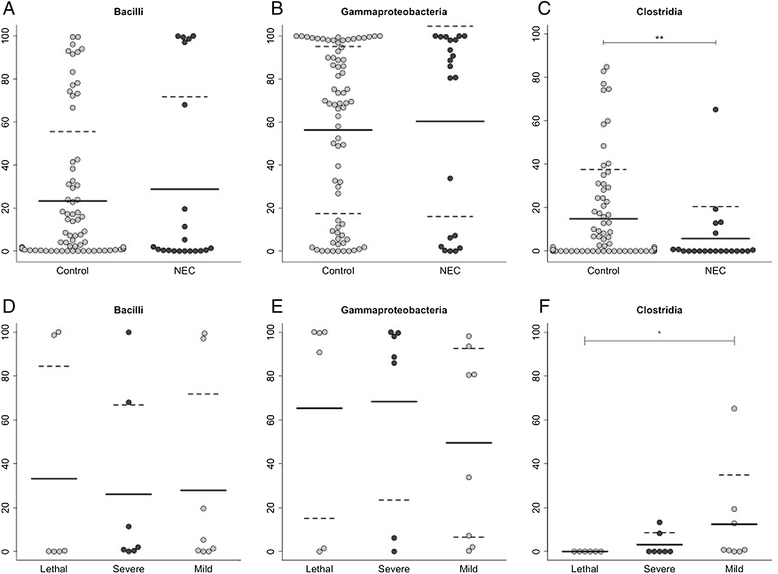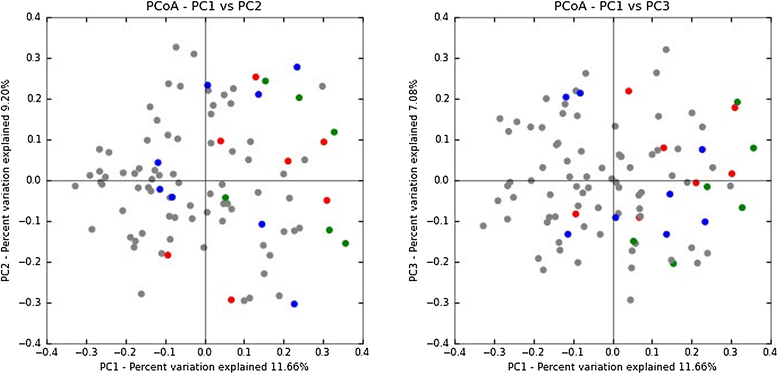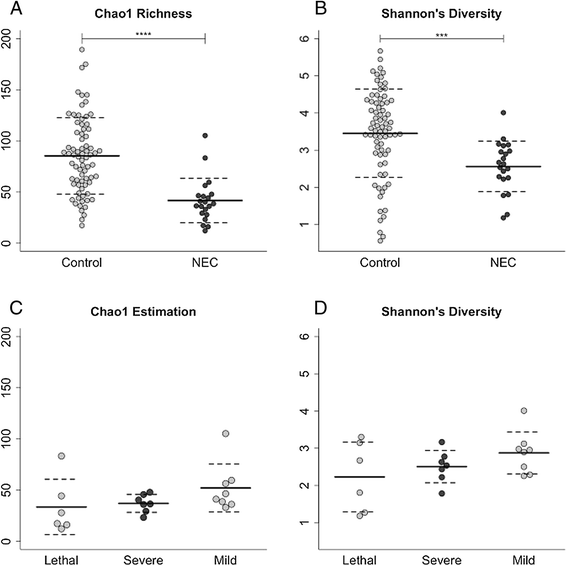Bacterial diversity and Clostridia abundance decrease with increasing severity of necrotizing enterocolitis
- PMID: 25810906
- PMCID: PMC4373520
- DOI: 10.1186/s40168-015-0075-8
Bacterial diversity and Clostridia abundance decrease with increasing severity of necrotizing enterocolitis
Abstract
Background: Necrotizing enterocolitis (NEC) is a devastating neonatal gastrointestinal disease that primarily affects premature infants. It is characterized by bowel inflammation and necrosis. In spite of extensive research, there has been little progress in decreasing the incidence or mortality of NEC over the past three decades. The exact etiology of NEC has not been identified. However, it is believed to result from an inappropriate immune response to gut microbiota. Using 454-pyrosequencing analyses of 16S rRNA genes that were PCR-amplified from stool DNA specimens, we compared the gut microbiota of infants with NEC to matched controls without NEC. The infants with NEC were then categorized into three subgroups based on severity: mild, severe, and lethal. We compared the microbiota among these subgroups and between each severity group and appropriate controls.
Results: Bacterial diversity and the relative abundance of Actinobacteria and Clostridia were significantly lower in NEC specimens compared to controls. The absence of Clostridia was significantly associated with NEC. Microbial diversity and Clostridia abundance and prevalence decreased with increasing severity of NEC.
Conclusions: Low bacterial diversity in stool specimens may be indicative of NEC and the severity of NEC. The low bacterial diversity, and the lack of Clostridia in lethal specimens, could indicate that the presence of a diverse bacterial population in the gut as well as the presence of taxa such as Clostridia may play a role in attenuating inflammation leading to NEC.
Keywords: Clostridia; Microbial diversity; Microbiota; Necrotizing enterocolitis.
Figures



Similar articles
-
Independence of gut bacterial content and neonatal necrotizing enterocolitis severity.J Pediatr Surg. 2017 Jun;52(6):993-998. doi: 10.1016/j.jpedsurg.2017.03.029. Epub 2017 Apr 5. J Pediatr Surg. 2017. PMID: 28410788 Free PMC article.
-
Abnormalities in microbial composition and function in infants with necrotizing enterocolitis: A single-center observational study.Front Pediatr. 2022 Oct 21;10:963345. doi: 10.3389/fped.2022.963345. eCollection 2022. Front Pediatr. 2022. PMID: 36340725 Free PMC article.
-
Low Microbial Diversity and Abnormal Microbial Succession Is Associated with Necrotizing Enterocolitis in Preterm Infants.Front Microbiol. 2017 Nov 15;8:2243. doi: 10.3389/fmicb.2017.02243. eCollection 2017. Front Microbiol. 2017. PMID: 29187842 Free PMC article.
-
Probiotics for prevention of necrotizing enterocolitis in preterm infants.Evid Based Child Health. 2014 Sep;9(3):584-671. doi: 10.1002/ebch.1976. Evid Based Child Health. 2014. PMID: 25236307 Review.
-
The intestinal microbiome and necrotizing enterocolitis.Curr Opin Pediatr. 2013 Jun;25(3):382-7. doi: 10.1097/MOP.0b013e3283600e91. Curr Opin Pediatr. 2013. PMID: 23657248 Review.
Cited by
-
[A review of the relationship between gut microbiome and necrotizing enterocolitis in preterm infants].Zhongguo Dang Dai Er Ke Za Zhi. 2018 Aug;20(8):680-685. doi: 10.7499/j.issn.1008-8830.2018.08.015. Zhongguo Dang Dai Er Ke Za Zhi. 2018. PMID: 30111480 Free PMC article. Review. Chinese.
-
Reducing Viability Bias in Analysis of Gut Microbiota in Preterm Infants at Risk of NEC and Sepsis.Front Cell Infect Microbiol. 2017 Jun 6;7:237. doi: 10.3389/fcimb.2017.00237. eCollection 2017. Front Cell Infect Microbiol. 2017. PMID: 28634574 Free PMC article.
-
The Microbiome and Biomarkers for Necrotizing Enterocolitis: Are We Any Closer to Prediction?J Pediatr. 2017 Oct;189:40-47.e2. doi: 10.1016/j.jpeds.2017.05.075. Epub 2017 Jun 29. J Pediatr. 2017. PMID: 28669607 Free PMC article. Review. No abstract available.
-
Exploring the Potential of Human Milk and Formula Milk on Infants' Gut and Health.Nutrients. 2022 Aug 29;14(17):3554. doi: 10.3390/nu14173554. Nutrients. 2022. PMID: 36079814 Free PMC article. Review.
-
Gut microbiota of preterm infants supplemented with probiotics: sub-study of the ProPrems trial.BMC Microbiol. 2018 Nov 13;18(1):184. doi: 10.1186/s12866-018-1326-1. BMC Microbiol. 2018. PMID: 30424728 Free PMC article. Clinical Trial.
References
LinkOut - more resources
Full Text Sources
Other Literature Sources
Miscellaneous

